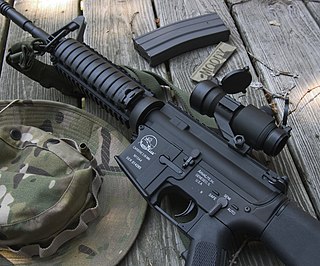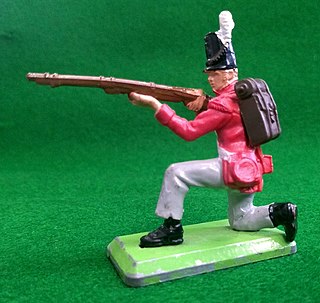
A firearm is any type of gun that uses an explosive charge and is designed to be readily carried and used by an individual. The term is legally defined further in different countries.
Toy guns are toys which imitate real guns, but are designed for recreational sport or casual play by children. From hand-carved wooden replicas to factory-produced pop guns and cap guns, toy guns come in all sizes, prices and materials such as wood, metal, plastic or any combination thereof. Many newer toy guns are brightly colored and oddly shaped to prevent them from being mistaken for real firearms.

Action Man is an action figure launched in Britain in 1966 by Palitoy as a licensed copy of Hasbro's American "movable fighting man", G.I. Joe.
Big Jim was a line of action figure toys produced from 1972 through 1986 by Mattel for the North American and European markets. He was renamed Kid Acero in Latin America and, for a short period of time, Mark Strong in Europe. Originally inspired by G.I. Joe, the Big Jim line was smaller in size and each figure included a push button in the back that made the character execute a karate chop action. The action figure's arms were made of a soft plastic/vinyl material and contained a mechanism that simulated the bulge of a biceps when the elbow was bent. Big Jim was less military-oriented than the G.I. Joe line, having more of a secret agent motif, but also had a large variety of outfits and situations available including sports, space exploration, martial arts, hunting, western, camping, fishing, and photography.

The 90 mm gun M1/M2/M3 was an American heavy anti-aircraft and anti-tank gun, playing a role similar to the German 8.8cm Flak 18. It had a 3.5 in (90 mm) diameter bore, and a 50 caliber barrel, giving it a length of 15 ft (4.6 m). It was capable of firing a 3.5 in × 23.6 in shell 62,474 ft (19,042 m) horizontally, or a maximum altitude of 43,500 ft (13,300 m).

A ranged weapon is any weapon that can engage targets beyond hand-to-hand distance, i.e. at distances greater than the physical reach of the user holding the weapon itself. The act of using such a weapon is also known as shooting. It is sometimes also called projectile weapon or missile weapon because it typically works by launching solid projectiles ("missiles"), though technically a fluid-projector and a directed-energy weapon are also ranged weapons. In contrast, a weapon intended to be used in hand-to-hand combat is called a melee weapon.

The Special Naval Landing Forces were naval infantry units of the Imperial Japanese Navy (IJN) and were a part of the IJN Land Forces. They saw extensive service in the Second Sino-Japanese War and the Pacific theatre of World War II.

The Ordnance Quick-Firing 6-pounder 7 cwt, or just 6-pounder, was a British 57 mm gun, serving during the Second World War as a primary anti-tank gun of both the British and United States Army. It was also used as the main armament for a number of armoured fighting vehicles.

A cap gun, cap pistol, or cap rifle is a toy gun that creates a loud sound simulating a gunshot and smoke when a small percussion cap is ignited. Cap guns were originally made of cast iron, but after World War II were made of zinc alloy, and most newer models are made of plastic. Cap guns get their name from the small discs of shock-sensitive explosive compounds that provide the noise and smoke, effectively the same as the Maynard tape primer and percussion caps used in real firearms of the mid to late 1800s but usually smaller and made from cheap plastic or paper. Some are arranged in plastic rings of eight or twelve. There are also single caps, roll caps, disk caps, and cap strips all of which are actually extremely small versions of percussion fireworks. Armstrong's mixture is often used today as the explosive, but previously the tiny powder charge was a simple mixture of potassium perchlorate, sulfur, and antimony sulfide sandwiched between two paper layers that hold in the gases long enough to give a sound report when the cap is struck.

Airsoft guns are replica toy guns used in airsoft sports. They are a special type of low-power smoothbore air guns designed to shoot non-metallic spherical projectiles (pb) often colloquially referred to as "BBs", which are typically made of plastic or biodegradable resin materials. Airsoft gun powerplants are designed to have low muzzle energy ratings and the pellets have significantly less penetrative and stopping powers than conventional airguns, and are generally safe for competitive sporting and recreational purposes if proper protective gear is worn.

Army men, or plastic soldiers, are toy soldiers that are about 5 cm (2.0 in) tall and most commonly molded from olive green plastic. Unlike the more expensive toy soldiers available in hobby shops, army men are sold at low prices in discount stores and supermarkets in bulk packaging. Army men are traditionally solid green and almost always dressed in modern military uniforms and armed with 20th-century weapons. 'Jumbo' army men are a less common secondary scale with 4.75-inch (12.1 cm) soldiers made with the same process.
Elastolin is a trademark used by the German company O&M Hausser for the toy soldiers and other types of figures it manufactured from composite material and later from plastic. The Hausser firm was founded in 1904 by Christian Hausser and his sons Otto and Max. The factory was situated in Ludwigsburg near Stuttgart. Production of all figures was interrupted when the German economy was put on a "total war" footing in 1943. Limited production of composition figures resumed several years after the end of World War II in 1945. Hausser continued to use the brand name Elastolin when it began production of figures in a hard polystyrene plastic in 1955 while production of figures in the older sawdust-based composition material continued into the 1969. Hausser production of plastic figures continued through 1982. The company filed for bankruptcy in June 1983 and ceased production by the end of the year.

The 76 mm gun M1 was an American World War II–era tank gun developed by the U.S United States Ordnance Department in 1942 to supplement the 75 mm gun on the basic Medium tank M4. It was also used to arm the M18 Hellcat tank destroyer.

The Hamilton's Invaders was a 1964 series of plastic toys of giant insect type monsters, toy soldiers and vehicles. The toyline was conceived and marketed by Remco on television during the early 1960s, inspired by the giant insect genre that were popular from the 1950s, that were in reruns on TV.
Moon McDare was an A. C. Gilbert Company toy line featuring a fictional male astronaut, released in response to the then current interest in outer space and the US/Soviet Space Race. Moon McDare stood approximately 12" (30.4 cm) high and was provided with a variety of space gear, including helmet, backpack and hand tools.

The Hasbro Action Man: 40th Anniversary Nostalgic Collection 2006-2010 were reproductions of the early period Palitoy Action Man figures, sold in collectors sets released in 2006. Four different boxed uniform sets and a boxed figure were released in each successive wave.

Britains' Deetail toy soldiers were a popular product in the 1970s and 1980s. Manufactured in England by W. Britain, the 1/32 (54mm) scale plastic figures were finished with hand painted details and came with sturdy Zamak metal bases. In the early 1990s production moved to China before eventually being phased out.
Secret Wars was a 1984-1985 line of action figures and playsets, launched as a tie-in between Marvel Comics and the Mattel toy company.

G.I. Joe: Ninja Battles is a 2004 computer-animated military science fiction action short film. The film was released on DVD as part of the Ninja Battles set of G.I. Joe: A Real American Hero figures. In it, the history of the Arashikage Clan, as well as the history of Snake Eyes and Storm Shadow's rivalry, are examined through a series of trials. Scenes from both G.I. Joe: Spy Troops and G.I. Joe: Valor vs. Venom are used, with a brief period of new animation at the end of the movie.